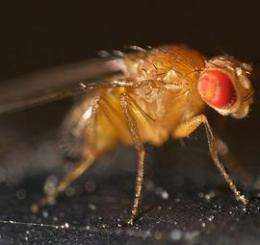Fruit fly antennae are tuned in

(PhysOrg.com) -- The antennal ears of different fruit fly species are actively tuned to high-frequency components of their respective mating songs, according to new research led by University College London scientists.
During courtship, male fruit flies serenade females with a ‘love song’ produced by quiet, close-range wing vibrations. The females hear these songs with their antennae, which pick up the resultant faint air currents. These courtship songs, identified in over a hundred different Drosophilid flies, are known to differ in their frequency composition across species. They are crucial to reproduction and are thought to have evolved in part to avoid cross-breeding between species.
The new study by Riabinina et al., published today in Current Biology, demonstrates that the flies’ antennal ears show active frequency tuning to the song specific to their species. Although the antennae’s underlying anatomical design appears to be the same across species, they differ significantly in terms of the frequencies they are tuned to.
The courtship behavior of Drosophila is a well established model for studying the basis of animal communication. However, although scientists understand a good deal about how courtship songs and pheromonal cues mediate mate and species recognition, little is known about the specific contributions of the flies’ ears.
Senior author Dr Joerg Albert, UCL Ear Institute, said: “This study shows that in seven members of the melanogaster species group, the flies’ antennal ears are mechanically tuned to different best frequencies and that these correlate with high-frequency elements of their courtship songs. We also demonstrate that this tuning is active rather than passive in that it relies on feedback from the flies’ auditory neurons and thus is physiologically vulnerable: if the flies are sedated, the tuning match disappears.
“The ears of fruit flies’ possess a kind of naturally built-in ‘hearing aid’ which amplifies sound in a nonlinear and frequency-specific way. As a result, the flies are very good at detecting faint sound of a certain frequency, such as the species-specific pulses which are a crucial element of each courtship song. At larger stimulus intensities, however, such as the flies’ own wing-beat during flight, this hearing aid automatically switches itself off and the ear functions like a simple, linear microphone. The songs are audible at astonishingly low volumes - it seems that when singing a love song to a fruit fly, it may be better to whisper than to shout.
“Fruit flies and mammals share a common evolutionary history of roughly 3 billion years, so looking at how their hearing has evolved has relevance to mammals and to humans. The model we look at in this study offers a promising means of exploring different elements of how auditory signalers and receivers have co-evolved, both with respect to the mechanisms and the molecules involved.”
More information: Research paper in Current Biology
Provided by University College London

















